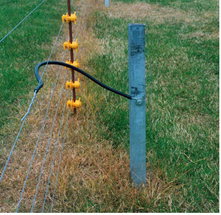EARTHING GUIDE FOR ELECTRIC FENCING
Earthing your electric fencing is as important as planning the layout or choosing a fence energiser, yet is often overlooked. Foolishly - up to 80 per cent of all electric fencing malfunctions are due to poor earthing.
An electric fence is installed as an open circuit originating at the fence energiser, with current carried by the fence wire - when an animal touches the wire, the current flows through the animal down to the ground, and returns to the energiser. For the animal to feel an effective shock, the earth system must be efficient enough to allow an unrestricted flow back to the energiser.
Installing an Earth
First, work out how many earth stakes you need. Larger fence energisers exerting more power, or longer fence lines with higher leakage, require substantially more earthing. As a rule aim for 1 metre of earth rod for every joule of energy, ie. a 5 joule energiser will require 5 metres of earthing. Your earth stakes should be at least 4 metres apart.
You need to link your earth stakes together with underground cable, which you then connect to the energiser's earth terminal.
Keep earth stakes away from domestic earth systems, and at least 10 metres away from any other earth installations, ie. those used by telephone or electricity supply companies. Never use steel water pipes or steel framed buildings as an earth.
You also need to place your earth system in a consistently damp site. In areas where the soil is very dry, or there is a lot of sand, peat, gravel, snow or frozen ground, you can boost the efficiency of the stake by watering the ground in dry weather or increasing the number of earth stakes. You can also run an earth return wire parallel to the fence line, and connect it to earth stakes at regular intervals as the photo above shows.
Bear in mind that an earth system installed in winter, which is adequate for winter conditions, may not be suitable for summer. This may explain any substantial loss in power on your electric fencing over the summer months.
Testing Your Earth System
First you need to create a dead short on your electric fence line, at least 100 metres away from the earth stakes, by laying an iron bar across the wires to ground. With a voltmeter, measure the voltage between the earth stakes and the ground. Anything above 200-300 volts indicates the earth is inadequate, and you should install extra rods at four metre spacings until the voltage comes back down to near zero.
Keep earth stakes away from domestic earth systems, and at least 10 metres away from any other earth installations, ie. those used by telephone or electricity supply companies. Never use steel water pipes or steel framed buildings as an earth.
You also need to place your earth system in a consistently damp site. In areas where the soil is very dry, or there is a lot of sand, peat, gravel, snow or frozen ground, you can boost the efficiency of the stake by watering the ground in dry weather or increasing the number of earth stakes. You can also run an earth return wire parallel to the fence line, and connect it to earth stakes at regular intervals as the photo above shows.
Bear in mind that an earth system installed in winter, which is adequate for winter conditions, may not be suitable for summer. This may explain any substantial loss in power on your electric fencing over the summer months.
Testing Your Earth System
First you need to create a dead short on your electric fence line, at least 100 metres away from the earth stakes, by laying an iron bar across the wires to ground. With a voltmeter, measure the voltage between the earth stakes and the ground. Anything above 200-300 volts indicates the earth is inadequate, and you should install extra rods at four metre spacings until the voltage comes back down to near zero.

